Related Research Articles

A comic strip is a sequence of cartoons, arranged in interrelated panels to display brief humor or form a narrative, often serialized, with text in balloons and captions. Traditionally, throughout the 20th and into the 21st century, these have been published in newspapers and magazines, with daily horizontal strips printed in black-and-white in newspapers, while Sunday papers offered longer sequences in special color comics sections. With the advent of the internet, online comic strips began to appear as webcomics.

A cartoon is a type of visual art that is typically drawn, frequently animated, in an unrealistic or semi-realistic style. The specific meaning has evolved, but the modern usage usually refers to either: an image or series of images intended for satire, caricature, or humor; or a motion picture that relies on a sequence of illustrations for its animation. Someone who creates cartoons in the first sense is called a cartoonist, and in the second sense they are usually called an animator.

Mutt and Jeff was a long-running and widely popular American newspaper comic strip created by cartoonist Bud Fisher in 1907 about "two mismatched tinhorns". It is commonly regarded as the first daily comic strip. The concept of a newspaper strip featuring recurring characters in multiple panels on a six-day-a-week schedule had previously been pioneered through the short-lived A. Piker Clerk by Clare Briggs, but it was Mutt and Jeff as the first successful daily comic strip that staked out the direction of the future trend.
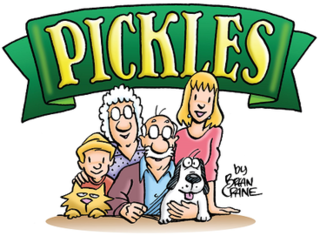
Pickles is a daily and Sunday comic strip by Brian Crane focusing on a retired couple in their seventies, Earl and Opal Pickles. Pickles has been published since April 2, 1990.

Nancy is an American comic strip, originally written and drawn by Ernie Bushmiller and distributed by United Feature Syndicate and Andrews McMeel Syndication. It was spun off from Fritzi Ritz, a strip Bushmiller inherited from creator Larry Whittington in 1925. After Fritzi's niece Nancy was introduced in 1933, Fritzi Ritz evolved to focus more and more on Nancy instead of Fritzi. The new strip took the old one's daily slot, while Fritzi Ritz continued as a Sunday, with Nancy taking the Sunday slot previously filled by Bushmiller's Phil Fumble strip beginning on October 30, 1938.

Non Sequitur is a comic strip created by Wiley Miller starting February 16, 1992 and syndicated by Andrews McMeel Syndication to over 700 newspapers. It is also published on gocomics.com and distributed via email.

Henry is a comic strip created in 1932 by Carl Thomas Anderson. The title character is a young bald boy who is mute. Except a few early episodes, the comic strip character communicates largely but not entirely through pantomime, a situation which changed when Henry moved into comic books. Henry has spoken in at least one Betty Boop cartoon from 1935. In the feature, Betty Boop has a pet shop and Henry speaks to a dog in the window.
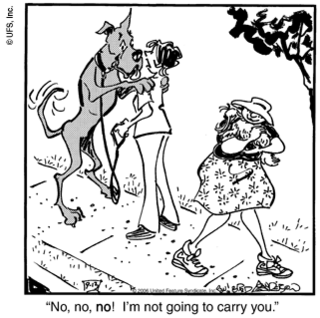
Marmaduke is a newspaper comic strip revolving around the Winslow family and their Great Dane, Marmaduke, drawn by Brad Anderson from June 1954 to 2015.
The comic strip switcheroo was a massive practical joke in which several comic strip writers and artists (cartoonists), without the foreknowledge of their editors, traded strips for a day on April Fools' Day 1997. The Switcheroo was masterminded by comic strip creators Rick Kirkman and Jerry Scott, creators of the Baby Blues daily newspaper comic strip.

Douglas S. Wildey was an American cartoonist and comic book artist best known for creating the 1964 animated television series Jonny Quest for Hanna-Barbera Productions.

The Newspaper Enterprise Association (NEA) is an editorial column and comic strip newspaper syndication service based in the United States and established in 1902. The oldest syndicate still in operation, the NEA was originally a secondary news service to the Scripps Howard News Service; it later evolved into a general syndicate best known for syndicating the comic strips Alley Oop, Our Boarding House, Freckles and His Friends, The Born Loser, Frank and Ernest, and Captain Easy / Wash Tubbs; in addition to an annual Christmas comic strip. Along with United Feature Syndicate, the NEA was part of United Media from 1978 to 2011, and is now a division of Andrews McMeel Syndication. The NEA once selected college All-America teams, and presented awards in professional football and professional [NBA] basketball.

Grin and Bear It is a former daily comic panel created by George Lichtenstein under the pen name George Lichty. Lichty created Grin and Bear it in 1932 and it ran 83 years until 2015, making it the 10th-longest-running comic strip in American history. Frequent subjects included computers, excessive capitalism and Soviet bureaucracy. Situations in his cartoons often took place in the offices of commissars, or the showrooms of "Belchfire" dealers with enormous cars in the background. His series "Is Party Line, Comrade!" skewered Soviet bureaucrats, always wearing a five-pointed star medal with the label "Hero".
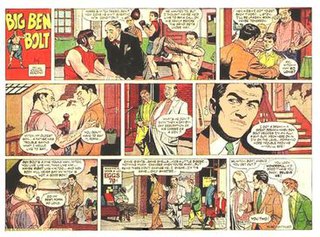
Big Ben Bolt is a comic strip that was syndicated from February 20, 1950 to April 15, 1978. It was drawn by John Cullen Murphy, written by Elliot Caplin, and distributed by King Features Syndicate. The strip followed the adventures of boxer and journalist Ben Bolt.
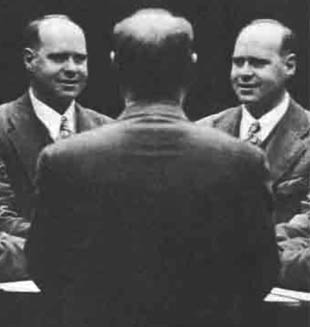
Irving David Breger was an American cartoonist who created the syndicated Mister Breger (1945–1970), a gag panel series and Sunday comic strip known earlier as Private Breger and G.I. Joe. The series led to widespread usage of the term "G.I. Joe" during World War II and later. Dave Breger was his signature and the byline on his books. During World War II, his cartoons were signed Sgt. Dave Breger.

Reg'lar Fellers is a long-running newspaper comic strip adapted into a feature film, a radio series on the NBC Red Network, and two animated cartoons. Created by Gene Byrnes (1889–1974), the comic strip offered a humorous look at a gang of suburban children. Syndicated from 1917 to January 18, 1949, Byrnes' strip was collected into several books. Branding also extended to such items as baseball bats and breakfast cereal.
Joe Martin is an American cartoonist.
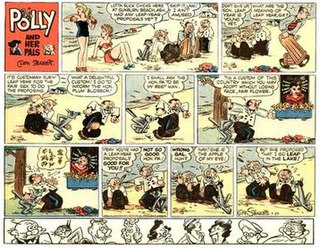
Polly and Her Pals is an American comic strip, created by cartoonist Cliff Sterrett, which ran from December 4, 1912, until December 7, 1958. It is regarded as one of the most graphically innovative strips of the 20th century. It debuted as Positive Polly on December 4, 1912, in William Randolph Hearst's newspapers, initially the New York Journal, and was later distributed by King Features Syndicate. The title changed to Polly and Her Pals on January 17, 1913.
Canadian comics refers to comics and cartooning by citizens of Canada or permanent residents of Canada regardless of residence. Canada has two official languages, and distinct comics cultures have developed in English and French Canada. The English tends to follow American trends, and the French, Franco-Belgian ones, with little crossover between the two cultures. Canadian comics run the gamut of comics forms, including editorial cartooning, comic strips, comic books, graphic novels, and webcomics, and are published in newspapers, magazines, books, and online. They have received attention in international comics communities and have received support from the federal and provincial governments, including grants from the Canada Council for the Arts. There are comics publishers throughout the country, as well as large small press, self-publishing, and minicomics communities.
Quincy is an American syndicated newspaper comic strip published from July 13, 1970 to October 4, 1986, created and produced by cartoonist Ted Shearer. The series, about an African-American boy being raised by his grandmother in Harlem, was one of the earliest mainstream comic strips to star an African American in the lead role, following Dateline: Danger! (1968-1974) and Luther (1969-1986). Another predecessor, Wee Pals, features an African-American among an ensemble cast of different races and ethnicities.
Charlie Chaplin comics have been published in the United States, the United Kingdom, and Europe. Charlie Chaplin comic strips first appeared in 1915 in the U.S. and the U.K., cashing in on the tremendous popularity of the comedian at the time; they were some of the earliest comics inspired by the popularity of a celebrity. Although Charlie Chaplin comic strips didn't enjoy enduring popularity in the U.S., a Chaplin comic strip was published in the U.K. from 1915 until the late 1940s, while in France there were Chaplin comics published for more than 50 years.
References
- ↑ Holtz, Allan (2012). American Newspaper Comics: An Encyclopedic Reference Guide. Ann Arbor: The University of Michigan Press. p. 269. ISBN 9780472117567.
- ↑ Gardner, Alan (2005-12-20). "Cartoonist Joe Martin Starts His Own Syndicate". The Daily Cartoonist. Retrieved 2015-01-18.
- ↑ Stephen, Paul (2015-01-18). "Prolific cartoonist who lives in area keeps up the pace". Star-News . Wilmington, N.C. Retrieved 2015-01-18.